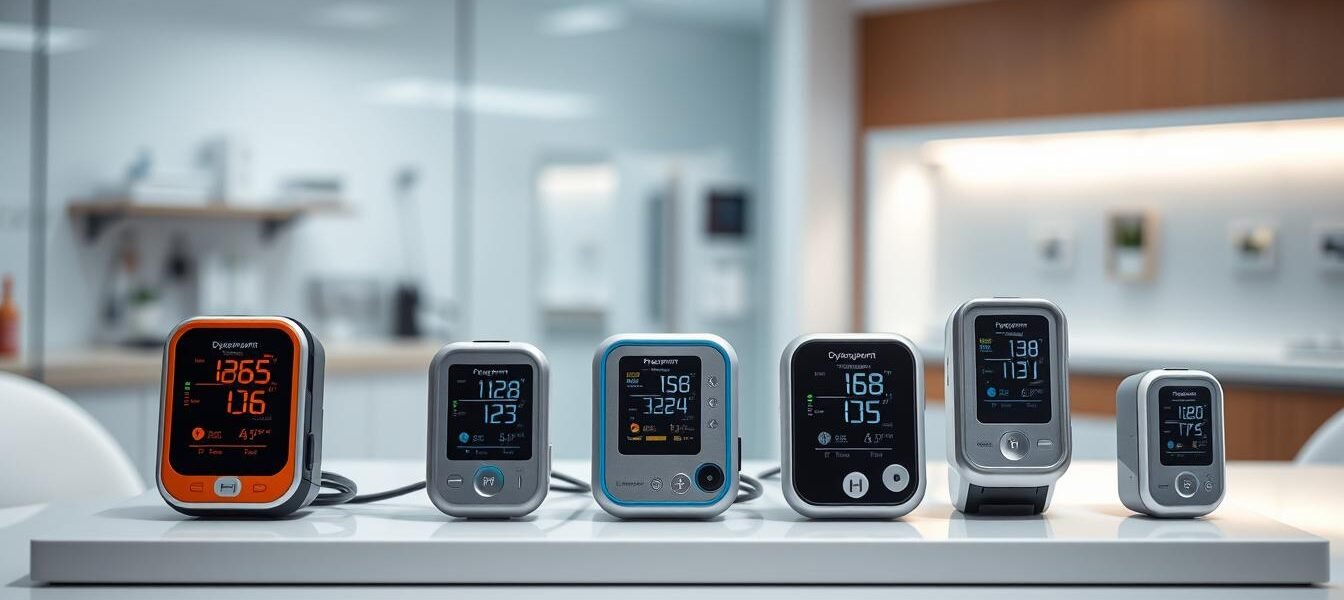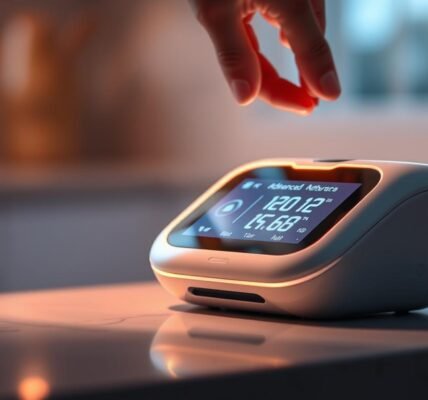“The greatest weapon against stress is our ability to choose one thought over another.” – William James. In diabetes management, choosing the right tools can reduce stress and improve health. By comparing insulin pumps, you’re taking a big step towards better diabetes control. This insulin pump buying guide will guide you through the many options and help you find the best insulin pumps of 2021.
Technology in insulin pumps is advancing fast, offering more features to improve life quality. These devices now include continuous glucose monitoring and automated delivery. Knowing their features and benefits is key to choosing the right one for you. By looking at different insulin pumps, you can find the perfect one for your needs, ensuring better diabetes care.
Key Takeaways
- Understanding the variety of insulin pumps available is crucial for effective diabetes management.
- Comparing features and benefits can help you make informed decisions.
- Insulin pumps have advanced significantly, offering functionalities like CGM and automatic delivery.
- The best insulin pumps of 2021 provide personalized solutions for users.
- Taking the time to compare insulin pumps leads to better health outcomes.
Understanding Insulin Pumps
Insulin pumps are key for people with type 1 diabetes. They use advanced insulin pump technology to give insulin all day long. This helps control blood sugar levels better.
Insulin is given in two ways: basal insulin all the time, and bolus insulin with meals. This helps manage blood sugar spikes after eating1. Unlike shots, pumps last years, with parts needing to be changed every few days2.
Insulin pumps make daily life easier. They have reservoirs and infusion sets, unlike syringe shots. Some pumps, called patch pumps, are waterproof, perfect for swimming and bathing2.
Many pumps work with continuous glucose monitors (CGM) to track blood sugar. This helps adjust insulin as needed1.
Insulin pumps are okay for kids as young as 2, but most are for kids 7 and up2. Some people might find them hard to use, like those with dexterity issues or allergies2. Still, they’re a great choice for managing diabetes and staying active.
| Pump Type | Delivery Method | Waterproof | Approved Age | CGM Compatibility |
|---|---|---|---|---|
| Tubed Pumps | Basal & Bolus | No | 2+ | Yes |
| Tubeless Pumps | Basal & Bolus | Yes | 2+ | Yes |
| Patch Pumps | Bolus Only | Yes | 7+ | Yes |
Importance of Insulin Pump Therapy
Insulin pump therapy is key for managing diabetes. It offers many benefits of insulin pump therapy that improve patient results. These devices make it easier to live your life and plan meals.
Users of insulin pumps face less severe hypoglycemia. They have 9.55 episodes per 100 patient-years, compared to 13.97 for those using injections. This means fewer risks from low blood sugar34.
Insulin pumps also lower the risk of diabetic ketoacidosis. They have 3.64 episodes per 100 patient-years, less than the 4.26 for injections34. Hemoglobin A1c levels, a measure of long-term glucose control, are better for pump users. They average 8.04%, compared to 8.22% for those on injections34.
Insulin pump therapy also means using less insulin. Users need only 0.84 U/kg, compared to 0.98 U/kg for injections34. This leads to better blood sugar control and lower insulin use, helping to manage diabetes more efficiently.
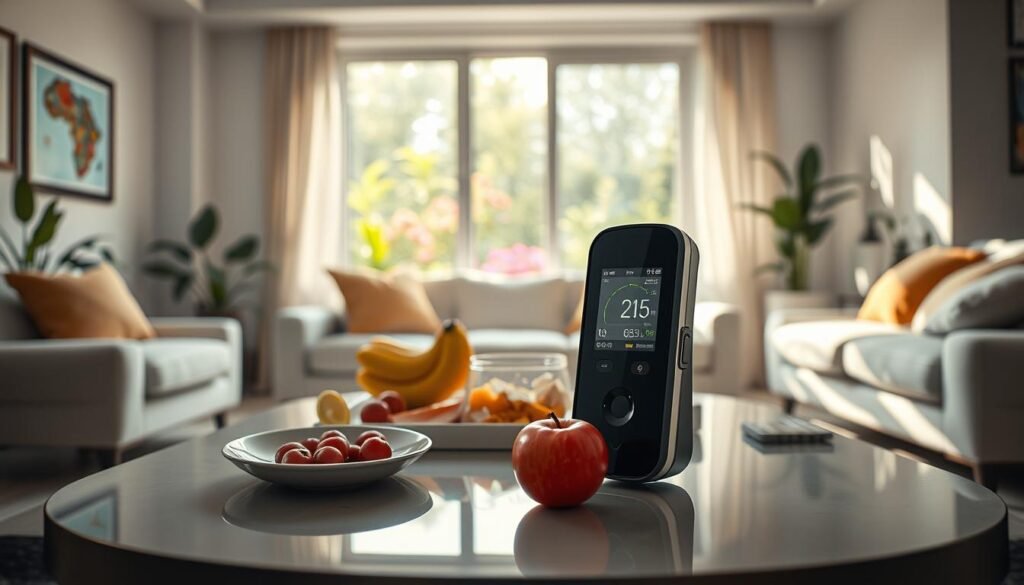
Over one million people worldwide use insulin pumps, with 350,000 to 515,000 in the United States. This shows the big impact on managing blood sugar5. Adding continuous glucose monitoring devices to insulin pumps makes care even better. It gives real-time data, improving health outcomes and quality of life for users5.
Key Features to Look for in Insulin Pumps
When looking at insulin pumps, it’s important to check several key features. These features can really help with managing your diabetes. Here are the main things to look at:
Continuous Glucose Monitoring (CGM)
Continuous glucose monitoring is a big deal in insulin pump therapy. It lets you see your blood sugar levels in real time. This way, you can adjust your insulin right away.
Pumps with CGM can even adjust insulin automatically. This can help keep your blood sugar in check and lower the chance of low blood sugar. It’s crucial to pick a pump that works well with your CGM or glucometer6.
Closed Loop Functionality
Closed loop systems are a big step forward in insulin delivery. They automatically adjust insulin based on your blood sugar levels. This is especially helpful when your activity or diet changes.
With closed loop systems, you might have fewer low blood sugar episodes. As technology gets better, more pumps will have these advanced features7.
Reservoir Capacity and Delivery
The size of the insulin pump’s reservoir is important. It determines how often you’ll need to refill or change your insulin. Different pumps have different sizes, so it’s key to choose one that fits your needs.
Think about how much insulin you use each day, how active you are, and how often you take boluses. If you use a lot of insulin, you’ll want a pump with a bigger reservoir8. Also, consider whether you prefer a pump with tubing or a tubeless option. This will affect how comfortable and easy to use the pump is for you.
How to Compare Insulin Pumps
When looking at insulin pump comparisons, it’s key to check several important factors. Start by looking at the reservoir capacity for insulin. For example, the Minimed 780G/770G has a 300U reservoir. On the other hand, the Omnipod DASH has a 200U capacity. This difference can greatly affect how well the pump meets your needs9.
Next, consider the battery life. Some pumps might only last 3 weeks, while others can last up to 7 weeks with lithium batteries10. This can impact how often you need to replace the pump.
It’s also important to look at the basal rate profiles. These profiles can vary a lot, with some pumps offering 12 to 48 customizable rates. Some even let you manage multiple profiles10. Check if the pump’s bolus increments can be adjusted, as they range from 0.05 to 1 unit increments. This affects how precise your dosages can be10.
Don’t overlook the warranties and support services from the manufacturers. Good customer support is as important as the pump’s features for troubleshooting or updates.
Lastly, compare insulin pump prices from different sellers. Looking for deals can help you save money. By following these steps, you can choose an insulin pump that fits your lifestyle and diabetes care needs.
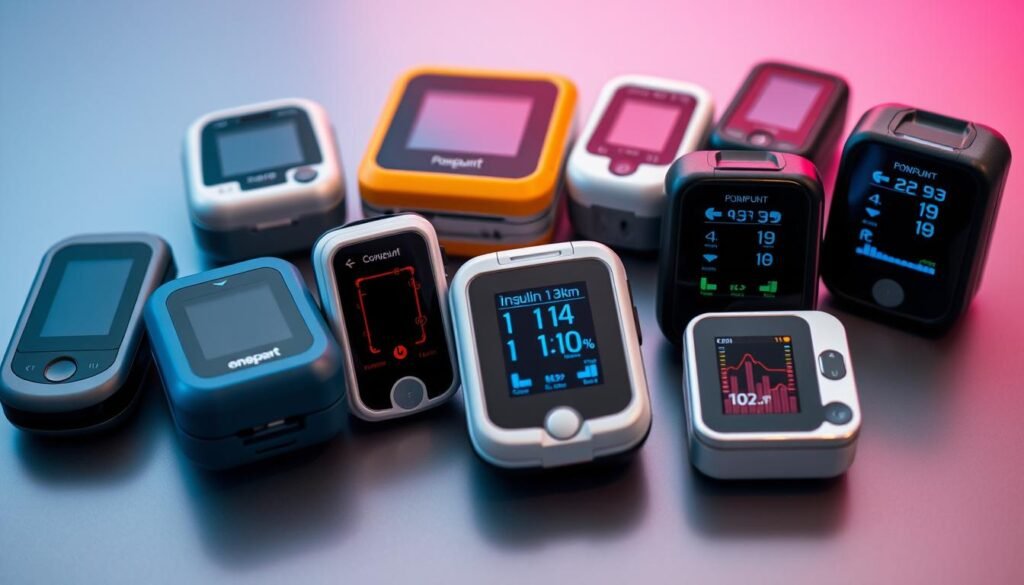
Top Insulin Pump Brands on the Market
Looking into the best insulin pump brands is key for those thinking about insulin pump therapy. The market is filled with top-rated options, each with its own strengths and user favorites. By looking at what each brand offers, you can find the best fit for your lifestyle.
Medtronic
Medtronic is a big name in insulin pumps, known for reliable systems with continuous glucose monitoring (CGM). The Medtronic MiniMed series helps keep blood sugar levels in check, great for those new to diabetes. Users often praise Medtronic for its quality and function, making it a top choice.
Tandem Diabetes Care
Tandem Diabetes Care stands out with its advanced insulin pumps, like the t:slim X2. It’s loved for its sleek design and easy-to-use interface. Its compatibility with many CGM systems makes it a favorite for better diabetes management. The Tandem t:slim X2 is known for its precise insulin dosing, a big plus for those needing exact amounts.
Omnipod
Omnipod is known for its tubeless insulin pumps, offering convenience and discretion. Its design provides steady insulin without the need for tubing. Many users prefer tubeless systems for their practicality. Omnipod’s focus on combining technology with diabetes care makes it a top pick among best insulin pump brands.
| Brand | Key Features | User Preference |
|---|---|---|
| Medtronic | CGM integration, reliable systems | High user satisfaction |
| Tandem Diabetes Care | Sleek design, precision dosing | Modern interface, CGM compatibility |
| Omnipod | Tubeless design, discreet usage | Convenience and flexibility |
Knowing about these top insulin pump options helps you make a smart choice for managing diabetes. For more details, check out a deeper look at insulin pump brands here11.
Latest Insulin Pump Models in 2021
The insulin pump market has seen big changes. This year, the Medtronic MiniMed 780G and the Tandem t:slim X2 stand out. They offer special features for your insulin needs, making them top choices.
Medtronic MiniMed 780G
The Medtronic MiniMed 780G is an upgrade from the MiniMed 670G. It was launched in 2017 and showed big improvements in time in range (TIR). It has automatic correction boluses and can adjust targets as low as 100 mg/dL.
In a study, the MiniMed 780G boosted TIR from 66% to 73% in three months12. It also has a 300-unit insulin capacity and includes continuous glucose monitoring (CGM) integration13.
Tandem t:slim X2
The Tandem t:slim X2 is another top pick for 2021. It has a 300-unit insulin capacity and comes with a built-in CGM that connects via Bluetooth13. It’s known for its easy-to-use touch screen and customizable settings.
It can handle up to 12 basal patterns for personalized care. Its insulin on board feature also makes it a favorite among users13.
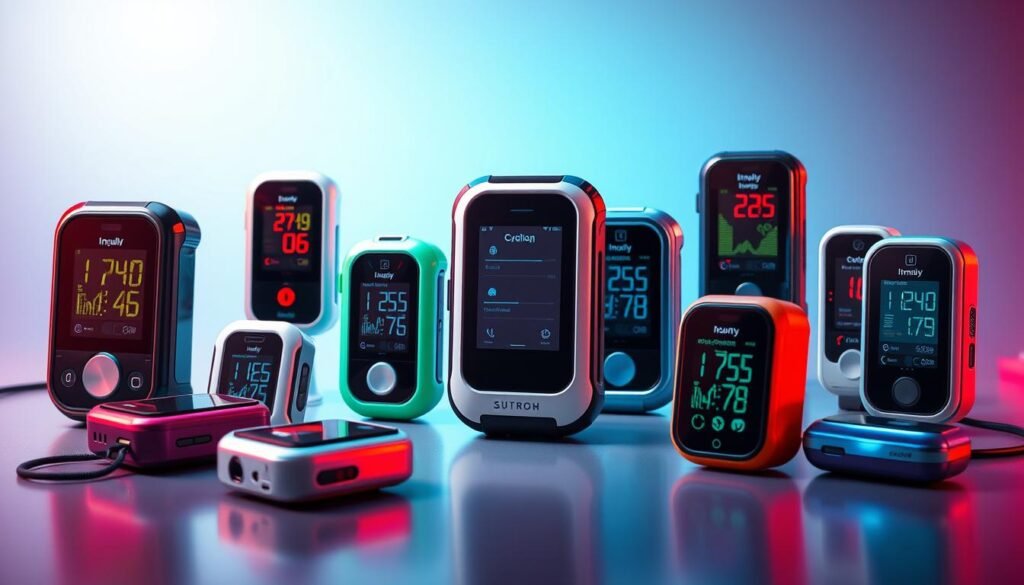
Understanding Insulin Pump Costs
When thinking about insulin pump therapy, knowing the insulin pump costs is key. The average price for an insulin pump is about $6000. You also need to add annual supply costs, which can be between $3000 to $600014. In the UK, buying one yourself can cost between £2000 and £3000, and it lasts 4 to 8 years15.
Keeping your pump in good shape and getting the right supplies is important. You might spend around £1500 or more each year on things like cannulas15. Families might save about $657 a year by switching from injections to pumps14.
Insurance also plays a big part in the cost. Many plans cover some or all of the costs of insulin pumps. It’s smart to compare prices and features to find the best pump for you. Think about both the initial cost and what you’ll spend on supplies over time.
Insulin pumps can greatly improve your life and lower the risk of severe low blood sugar14. But, they can also break down and need constant care15. Think about these points when deciding if the costs are worth it for you.
Insulin Pump Reviews and User Feedback
User feedback and expert insights are key in picking an insulin pump. By looking at insulin pump reviews and insulin pump ratings, you can learn a lot. Hearing from others can show how well a pump works in real life.
Community Perceptions
People share both good and bad experiences with insulin pumps. Many like the Omnipod DASH for its light weight, just 26g16. Others find Medtronic pumps easy to use, thanks to the MiniMed Mobile App16. Users also talk about their favorite features, like CGM systems and how well they manage diabetes.
Expert Ratings
Experts give detailed reviews of insulin pumps. For example, the Tandem t:slim X2 uses Basal-IQ to cut down on low blood sugar17. A study showed 99% of users liked it, making it a top choice17. Over 5,000 Basal-IQ users say it’s trustworthy and easy to use17. Combining user stories with expert opinions helps you choose wisely.
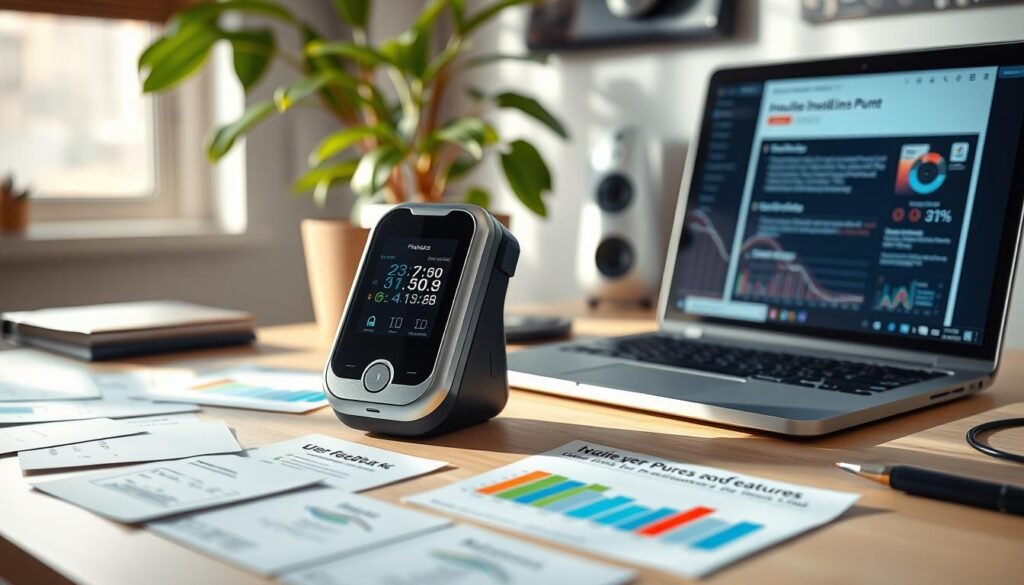
Insulin Pump Comparison Chart
The insulin pump comparison chart is a key tool for users looking to compare different models. It helps you see important features, costs, and what others think. This makes choosing the right pump easier.
| Insulin Pump | Approved Ages | CGM Integration | Weight | Reservoir Size | Special Features |
|---|---|---|---|---|---|
| Medtronic 770G/780G | All ages | Yes | 95.7g | 3ml | Hybrid Closed Loop, Auto adjustments |
| Tandem T:Slim x2 | All ages (Control IQ >6 years) | Yes | 112g | 3ml | Auto basal adjustments, Dual bolus option |
| YpsoPump | All ages (Auto Mode >1 year) | No | 83g | 1.6ml | Mobile app bolus calculator |
| Omnipod DASH | All ages (funded by private insurance) | No | 26g | 2ml | Wireless, Dual bolus giving |
This comparison highlights what makes each pump different. It helps you see which pump fits your needs best. Knowing what each model offers helps you make a smart choice for managing your diabetes.
Using a comparison chart makes it easy to look at all your options. It gives you a clear view of what each pump offers. This way, you can choose a pump that fits your lifestyle and health needs161819.
Top Rated Insulin Pump Options
Managing diabetes well needs the right tools. Choosing from the best insulin pumps can really help. Over 20 years, the number of adults with diabetes has doubled. This shows we need better ways to manage diabetes20.
The Medtronic MiniMed 670G is a top pick. It has SmartGuard Auto Mode. This adjusts insulin based on your blood sugar, helping avoid highs and lows11.
The Tandem t:slim X2 is also a favorite. It’s 38% smaller than many others20. It has Control-IQ Technology that stops insulin when your blood sugar is low. This makes managing diabetes easier and more convenient11.
The Omnipod Dash is known for its tubeless design. It delivers insulin for up to 72 hours and has a huge food library. This makes it a top choice for diabetes management11.
When picking a pump, cost is important. High-tech pumps can be pricey21. Think about how easy it is to use, how well it connects with technology, and what others say about it.
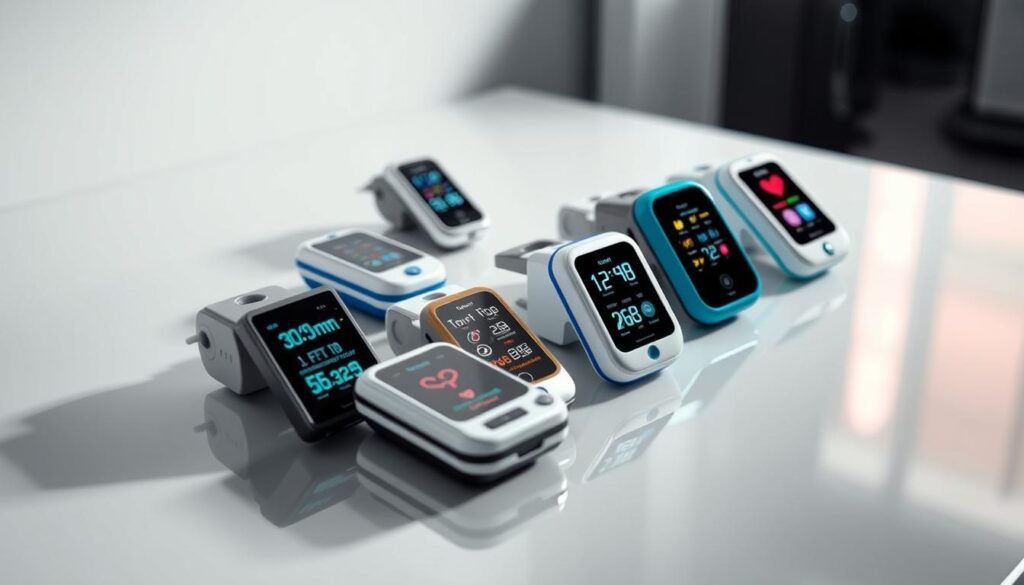
Affordable Insulin Pump Choices
Looking for affordable insulin pumps is important for many. Luckily, there are affordable insulin pump options that offer key features at a lower cost. These options help manage type 1 diabetes well without breaking the bank.
Budget-Friendly Models
Some insulin pumps are known for being both affordable and functional. For example, the Medtronic MiniMed™ 630G system works well for insulin needs, especially for those 14 and older with the right sensors22. Patch pumps like the Omnipod are also popular for their design, offering more freedom and a less visible look23.
This is great for those who don’t like the look of traditional pumps.
Insurance Coverage Considerations
Insurance coverage is a big factor in how affordable insulin pumps are. It’s important to talk to your insurance about what they cover. Sometimes, certain pumps might not be covered due to training or contracts23.
If you can’t get the pump you want, ask about training or look for other clinics with more options.
By using these tips, you can find affordable insulin pumps that work well. Remember, managing your diabetes means looking at all options for the right equipment.
| Model | Age Requirement | Key Features | Type |
|---|---|---|---|
| Medtronic MiniMed™ 630G | 14 years+ | SmartGuard™ feature, Guardian™ Sensor | Tethered |
| Omnipod | Determined by provider | Tubeless, waterproof | Patch |
| Medtronic MiniMed™ 770G | 2 years+ | Auto Mode, SmartGuard™ technology | Tethered |
Benefits of Using Insulin Pumps
Insulin pump therapy has many benefits for managing diabetes. It allows for precise insulin dosing, keeping blood sugar levels stable. This reduces the risk of severe low blood sugar, as studies show pump therapy improves blood sugar control24 and25.
The benefits of insulin pump therapy apply to both adults and kids. Research shows pumps can lower HbA1c levels, which is key for diabetes control. This reduces the risk of long-term diabetes complications26. In kids and teens, almost 87% of studies found a big drop in HbA1c levels after starting pump therapy24.
Insulin pumps also lower the risk of diabetic ketoacidosis (DKA). They provide steady insulin, avoiding sudden blood sugar drops26 and25. Plus, changing the cannula every 2-3 days helps keep insulin absorption high and infection rates low26.
Many people find the flexibility of lifestyle with insulin pumps a big plus. They can control meal and insulin timing better, leading to a more active life. Users need to test their blood sugar 4-6 times a day or use continuous glucose monitoring for good control26.
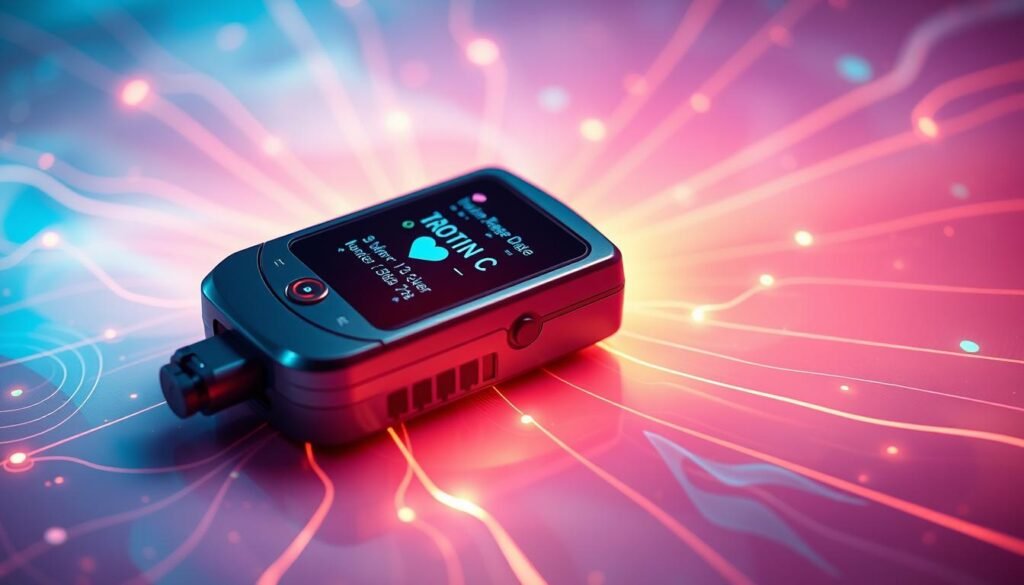
Overall, insulin pump therapy gives you better tools for managing your health. It helps keep your blood sugar in check and reduces diabetes risks, making your health journey more confident.
Common Challenges with Insulin Pumps
Insulin pumps offer many benefits, but users face some insulin pump challenges. One big issue is keeping the device in good shape. This is key for accurate insulin delivery and performance. If you ignore this, you might get wrong doses and face health risks.
Another problem is skin irritation from the pump or infusion site. It’s important to change sites often and watch for any bad reactions to the adhesive. Research shows that skin issues can happen when using insulin pumps with Continuous Glucose Monitors (CGMs)2728.
Learning to use an insulin pump can be hard, especially for beginners. It takes time to get the hang of managing settings and understanding how insulin works. With help from healthcare pros, you can learn to use the pump well.
Also, the cost of insulin therapy is a big problem for many. Even as technology improves, making these devices affordable for all is crucial. Talking regularly with your diabetes team can help you overcome these insulin pump challenges. This way, you can get the most out of your therapy and live better.
Tips for Choosing the Right Insulin Pump for You
Choosing the right insulin pump is key to managing diabetes well. Start by thinking about what you need and how you live. Look at the reservoir/cartridge size; a pump that holds enough insulin for three days can save you from changing cartridges too often29.
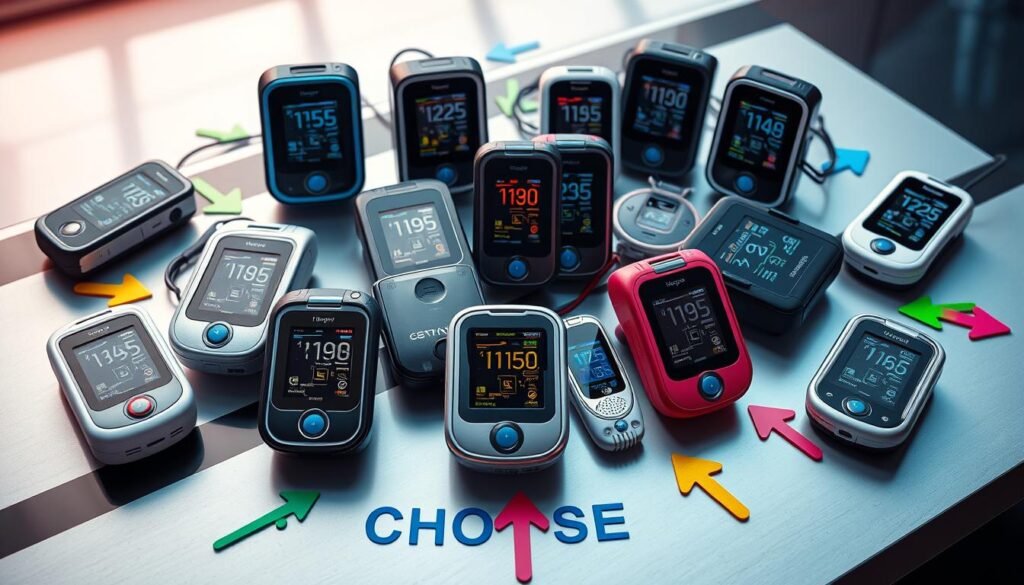
Next, check out the cannula choices the pump offers. Pumps have different lengths, angles, and materials to match what you’re used to29. Make sure the pump works with your insulin, like Fiasp or Lyumjev, for the best results29.
Think about the charging method of the pump. Some, like the Medtronic 780G, need batteries, while others, like Tandem T:Slim, recharge29. Also, see if you can control the pump with your phone for extra convenience29.
Consider the screen size and whether you like a touchscreen or buttons. If you want automated insulin delivery, check if the pump works with certain glucose sensors like Dexcom G629.
Don’t forget about insurance coverage. Knowing what your plan covers can help with costs. Some plans cover pumps differently, so it’s important to check6.
Think about whether you prefer a tubeless or tubing pump. Tubeless pumps are great for active people, while tubing pumps might be better for activities like swimming6. Also, look at the different alarm features and functions to see what fits your needs6.
Finally, see if the pump works with continuous glucose monitors or glucometers. Many pumps have features to help you manage your diabetes better6. Talk to your healthcare provider to make sure you understand all about the pump you’re considering6.
For more tips on choosing the right insulin pump, check out resources made for people going through this process.
Conclusion
When looking at insulin pumps, it’s key to use a good comparison guide. Insulin pumps offer many benefits, like better blood sugar control and more treatment satisfaction than shots. Studies show pump users see a bigger drop in HbA1c levels over two years, showing pumps can help manage diabetes better30.
About 40% of type 1 diabetes patients in the USA use insulin pumps, but in the UK, it’s only 6%31. This shows how personal choices and access to care play big roles in managing diabetes. The benefits of insulin pumps go beyond just blood sugar control. They also improve life quality and satisfaction, which are important when making a choice.
Choosing the right insulin pump is all about doing your homework and thinking about what you need. Being well-informed is crucial. Use the information from this article to help find the best insulin pump for your diabetes care needs.
FAQ
What is an insulin pump and how does it work?
What are the benefits of using an insulin pump?
How do I choose the right insulin pump for my needs?
What are the top-rated insulin pumps available in the market?
What should I look for in an insulin pump comparison?
Are there affordable insulin pump options?
What challenges might I face when using an insulin pump?
Source Links
- https://diabetes.org/about-diabetes/devices-technology/insulin-pumps-relief-and-choice
- https://my.clevelandclinic.org/health/articles/insulin-pumps
- https://pmc.ncbi.nlm.nih.gov/articles/PMC5818842/
- https://pubmed.ncbi.nlm.nih.gov/29049584/
- https://www.adces.org/education/danatech/insulin-pumps/pumps-in-professional-practice/dces’s-and-pump-therapy
- https://www.adces.org/education/danatech/insulin-pumps/insulin-pumps-101/choosing-the-right-pump
- https://dtc.ucsf.edu/types-of-diabetes/type1/treatment-of-type-1-diabetes/medications-and-therapies/type-1-insulin-pump-therapy/pump-faqs/
- https://pmc.ncbi.nlm.nih.gov/articles/PMC6695255/
- https://waltzingthedragon.ca/diabetes/insulin-pumps-cgm/choosing-insulin-pump-comparison-of-pumps-available-canada/
- https://www.betterlivingnow.com/forms/Insulin-Pump-Comparison.pdf
- https://www.byramhealthcare.com/blogs/best-insulin-pumps-diabetes-management
- https://pmc.ncbi.nlm.nih.gov/articles/PMC9354504/
- https://myendoconsult.com/learn/best-insulin-pump/
- https://pmc.ncbi.nlm.nih.gov/articles/PMC4730130/
- https://www.diabetes.org.uk/about-diabetes/looking-after-diabetes/treatments/insulin/insulin-pumps
- https://diabetes.thekids.org.au/contentassets/2a064fa16d9a4064b853951816aa1eb0/pump-comparison-table-2022.pdf
- https://www.healthline.com/health/diabetes/tandem-diabetes-basal-iq-review
- https://consumerguide.diabetes.org/collections/pumps
- https://monashchildrenshospital.org/wp-content/uploads/2024/10/insulin-pump-comparison-guide.pdf
- https://www.medicalnewstoday.com/articles/insulin-pump
- https://londondiabetes.com/news-and-events/whats-the-best-insulin-pump-for-me/
- https://www.medtronicdiabetes.com/products/compare-medtronic-insulin-pump-systems
- https://breakthrought1d.org.uk/knowledge-support/managing-type-1-diabetes/guide-to-type-1-diabetes-technology/insulin-pumps/insulin-pump-choice/
- https://www.diabetes.co.uk/insulin-pumps/pros-cons-of-insulin-pumps.html
- https://myhealth.alberta.ca/Health/pages/conditions.aspx?hwid=zx1815
- https://londondiabetes.com/news-and-events/pros-and-cons-of-insulin-pumps/
- https://pmc.ncbi.nlm.nih.gov/articles/PMC9534591/
- https://www.umassmed.edu/dcoe/diabetes-education/pumps_and_cgm/
- https://www.cuh.nhs.uk/patient-information/choosing-my-insulin-pump-the-wolfson-diabetes-and-endocrine-clinic/
- https://www.bmj.com/content/356/bmj.j1285
- https://psnet.ahrq.gov/web-mm/are-two-insulin-pumps-better-one
